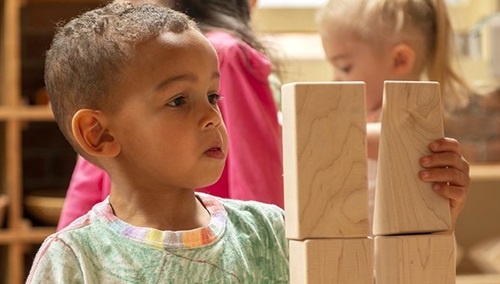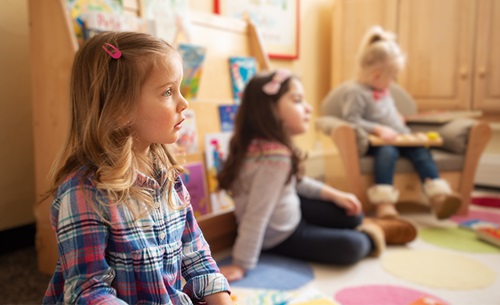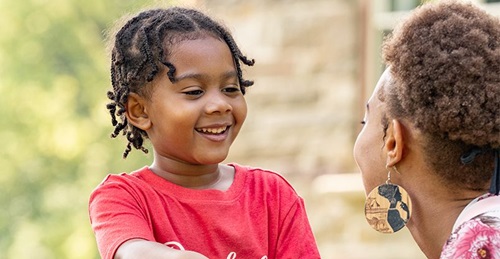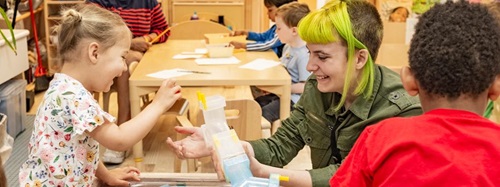Let Them Play!
It's vital to the learning process.
|
January 2014
The Value of Play
Play is one of the primary approaches to learning available to children in early childhood. Sense impressions and ideas bubble up from within them, much as they do in an artist or a composer. The children use the arts as a form of expression but most often they use play itself to express their ideas. Through play they try on every role and situation they've encountered in life. They explore the world around them and make it their own. Their play is often serious, but it is also enjoyable and deeply satisfying.
Yet despite its importance for cognitive, social-emotional and physical growth, play has largely been pushed out of kindergartens and is currently vanishing from preschools. It has been replaced with teacher-led instruction. Research and commentary about this situation can be found in the Alliance for Childhood's report, Crisis in the Kindergarten, and in an article, “The Crisis in Early Education,” both by Edward Miller and myself.
Reading at Five?
One thing that has moved early education in the U.S. away from play and toward cognitive instruction is the widespread belief that children should learn to read at five. The assumption is that they will be better readers than if they wait until six or seven. But there is essentially no evidence that this is true. Fortunately, the Common Core Standards are a bit vague on this point. They call for kindergarten children to read “emergent-reader texts with purpose and understanding.” There does not seem to be widespread recognition of what emergent-reader texts are which leaves room for interpretation. The primary goal should be that young children begin building the bridge toward print literacy, not that they cross the bridge and stand firmly on the other side.
Many other countries do not begin formal reading until age six or seven. They use guidelines similar to those proposed by Bank Street College in New York. Bank Street, a highly respected college for early childhood educators, identifies three stages of reading: emergent readers in preschool, kindergarten, and first grade; early readers in first and second grade; and early fluent/fluent readers in second and third grade. Working with this approach allows time for preschool and kindergarten children to slowly but effectively build a bridge from oral language to written language. And it allows time for play-based learning.
Play-based learning is a term that embraces two approaches simultaneously. One is that children are given ample time to carry their own ideas into play—with assistance from teachers as needed. The other is that their knowledge of the world has been enriched through appropriate content offered in interesting and experiential ways by their teachers. This can include reading of books, storytelling, puppetry, music, and the arts, as well as encouraging hands-on activities and exploration of nature. The children's own play and the content offered by teachers enhance one another. One child succinctly expressed it this way: “At recess I remember everything I learned.”
Compelling Research
Many studies documenting the value of play in early learning have been summarized in a brief and very readable book titled A Mandate for Playful Learning in Preschool by Kathy Hirsh-Pasek and others. Among the studies they report is one by Herb Ginsburg of Columbia University. He and Kyoung-Hye Seo filmed 90 preschool children during free play. Each film lasted 15 minutes. The content was then analyzed and the researchers found that regardless of children's social class, about half of the play scenarios contained mathematical activity, including patterns and shapes, magnitude of different objects, and number or quantity. No one assigned them these themes. They arose spontaneously.
A Mandate for Playful Learning also reports on a number of studies that indicate that heightened language skills are exhibited in connection with children's play. For example, a longitudinal study by David Dickinson and Patton Tabors, the Home-School Study of Language and Literacy Development, followed 74 children from low-income homes from three years of age through middle school. The research showed a clear relationship between the children's use of language during early childhood play and their later literacy outcomes.
There are other studies that show long-term gains for children in play-based programs. A striking example is the HighScope Preschool Curriculum Comparison Study (PCCS). It was a companion study to the well-known Perry Preschool study that showed the importance of preschool education for children from low-income homes. The PCCS went further and showed that play-based programs can lead to much better long-term outcomes for children than instructional programs.
PCCS researchers assigned 68 at-risk children to one of three preschool programs. The HighScope program and the traditional nursery were both play-based and yielded similar outcomes. The third classroom was heavily cognitive in orientation and used a scripted program. At the end of the first year it seemed that all students advanced equally, but the youngsters were followed until age 23. Over time the children who attended the cognitive class needed special education far more often than those from the play-based programs (47% compared to 6%). Also, the students from the cognitive class were more likely to later be arrested for felony offenses (34% vs 9%).
Long-term gains for children from play-based classrooms were also found in Germany in a study done in the 1970s. In this case children from 50 kindergarten classes that were play-based were compared with the same number from cognitively-oriented kindergartens. The children were followed until age ten. The study, reported by Linda Darling-Hammond and Jon Snyder in the Handbook of Research on Curriculum, found that children from the play-based kindergartens excelled over those in the cognitive classrooms in all 17 measures used, including creativity, oral expression, and “industry.” The study was so convincing that Germany, which was moving rapidly toward academic kindergartens, switched back to play-based programs.
Why is play so important in early learning?
Play has been likened to the inquiry-based approach of a scientist. Both engage in "what if" thinking. The child is continually trying out new possibilities and learns as much from failure and mistakes as from positive outcomes. It is the process that is of great importance to the child rather than the outcome. However, it is difficult to assess process, which is one reason that play has fallen out of favor in schools.
Creativity, curiosity, play, and problem-solving are all intertwined in early childhood. Social negotiation is also frequently part of the mix. “Let's play this way.” “No, let's do it my way.” Then the conversation begins. At age three it might end in a tussle. By age five children have become very adept in their use of language in play and in their ability to negotiate socially. This holds true for children from all socio-economic backgrounds.
It is increasingly the case, however, that children from all backgrounds enter preschool with undeveloped play abilities. There are many reasons, but among them are too many hours of screen time during which children view other people's creativity rather than developing their own. In addition, modern toys are often related to films or television shows and come with a clear story line, making it difficult for children to create their own stories. To engage in creative play of their own making, children find it very helpful to be given simple, open-ended play materials. Almost anything becomes a good toy in the hands of a playful child—blocks and other building materials, ropes, cloths, household items, and simple dress-ups are used in new ways every day. They offer children the chance to express their ever-changing understanding of the world.
Encouraging Play in the Classroom
Many children play well in school as soon as they realize it is allowed. Others need help from teachers who, themselves, need to understand play and ways to cultivate it in children. Young teachers often did not grow up with much playtime and benefit from experiences with creative play. Even older teachers who did play as children may need some prompting to recall open-ended play strategies. Sharing play memories with one another is a great help, as is engaging in actual play.
Many teachers are fearful of play in the classroom. In their minds, play is synonymous with chaos. But when children are deeply engaged in play they tend to be focused and fairly quiet. There is a “hum” of play that fills the room, with occasional loud voices that then quiet down again. This is true of young children but also of school-age children. For the PBS documentary, “Where Do the Children Play?” we organized a play session for fifth graders at a public school in Flint, Michigan. At the end of the hour-long film shoot, the teacher who had been quite apprehensive about play, remarked that it had not been chaotic at all. The children had played with enormous concentration using cardboard boxes, old sheets, ropes, and tape, and they played with children they did not usually socialize with.
Given all the benefits of play, what can teachers do to facilitate and support more play in their classrooms? Here are five suggestions:
- Encourage open-ended play by providing simple materials that children can adapt to all their needs: blocks, stones, logs, boxes, fabric, clothes line and clothes pins, etc.
- Provide rich language and content to spark children’s play through story telling, puppetry, books, songs, verses, and nursery rhymes.
- Be sure you are comfortable with play. Draw on your own childhood experiences, share play memories with others, and explore play now with blocks, mud pies, and dress ups.
- Deep, satisfying play needs time. Let children play for 45 minutes or more, giving help as needed, but letting children initiate and direct their own play.
- Help parents appreciate play. Direct them to articles, websites and videos. Organize a play session as part of a parent evening and have them also share play memories.
No Excuses
The Common Core Standards do not preclude play from kindergartens, and they should not serve as an excuse for removing it from preschools, although anecdotal reports indicate that that is happening. Rather, the Common Core Standards were created to help graduates enter the workplace and college. A recent IBM Institute study asked 1,500 CEOs around the world what they most sought in employees. The answer was simple: Creativity. There is no better way to foster creativity than to keep it alive in early childhood when it is naturally very strong and expresses itself through play. Yet teachers tell us that if they give their children time to play, some have no ideas of their own, or do not know how to engage in make-believe play.
Further, Kyung Hee Kim at William and Mary College, using scores on the Torrance Test of Creative Thinking found that creativity levels had risen from the 1950s to 1990 but then began to decline, especially among children. She is now frequently asked by business schools to help them develop courses that will stimulate creative thinking. The irony is not lost on her that we are driving creativity out of young children and then trying to restore it in college students.
Play-based education in preschool and kindergarten gives children a chance to develop their creativity in balanced ways. It supports the overall healthy development of children and prepares them for the 21st century workplace where creativity is highly valued.
Responses:
We must, as early childhood professionals, not allow pressure to conform over power our commitment to the values and principles of our work and the research that confirms the value of play in the lives and learning of children. It Is not rational to believe that acting in opposition to the natural instincts of childhood will produce superior academic outcomes, rather working in concert with these natural instincts will capture the energy and compound the potential they provide. To take the joy, pleasure, wonder and surprise out of childhood is to rob the child of a most wondrous and exciting time. To make childhood learning a drudgery of facts untimely and improperly presented, is to create in children a disdain for and dislike of that which we most want them to cherish; the desire to pursue lifelong learning and the capacity to profit from it.
I challenge us to provide the professional development opportunities and relationships that enhance teacher performance and support them in doing what they know is correct and beneficial for the children they serve. I encourage each of us to stand firm against coercion, intimidation and fear of negative evaluation. Let the proof of our commitment be the gains that children demonstrate in meeting and surpassing the expectations of policy makers and other stake holders. Stand up, stand out, stand alone if need be, but stand for best practices in the field of Early Childhood Education!
Habibah A. Rahman, M.Ed.
In the article I particularly liked the paragraph describing the Bank Street College guidelines identifying the three stages of reading. I believe that the majority of early childhood educators would agree with the author about the value of play but are being pressured by the policymakers to "prove" academic growth using frequent assessments. In the book The Pre-K Debates: Current Controversies & Issues edited by Edward Zigler, Walter Gilliam, and Steve Barnett there is an article called "The Cognitive/Academic Emphasis versus the Whole Child Approach: The 50-Year Debate" by Sandra J. Bishop-Josef and Edward Zigler which supports Joan Almon's viewpoint as well as examining how the pendulum has swung back and forth over the years.
Carol Patrick
[Play] is also being pushed out of the upper grades. Government thinks they know better but they don't listen to reality. They are supposedly concerned about obesity yet they cut recesses and active classes and give the kids computers. Children need movement, they need play, they need music and they need art! Wake up America!
Roann Keen
I am fortunate to work in a child care pre-school setting that promotes hands on, play curriculum. The school has been promoting this teaching for over 40 years. Parents continually tell us that it was the best start their children could have had for successful school years. Children are pressured too much too early to learn sit down, pencil and paper academics before having the play precursors. Thank you for having your wonderful articles on play.
Renee Templer
Thank you so much for this article. I have been teaching for 23 years in Tennessee, in Monroe County, Alcoa City, 3 Blount County schools, inclusive pre-k and 4 different Voluntary Pre-K classrooms and I am saddened and terrified at the shift in the paradigm from play to academics and computers. Now i am a computer geek, love technology for myself, however, I agree 150%. We are ruining our children by taking away play. I see an increase in frustration of both teachers and young students. An increase in stress, bullying, and teasing behaviors. I see kindergarten kids bragging about how much smarter they are than others who aren't ready to memorize their letters yet. Honestly, I can sit down and drill and kill and teach almost anyone their abc's and 123' s. But if the kids hate school, see teachers as something static in front of a classroom and uncaring, much like a computer(whether they are our not), and can see the teachers hate doing it, what good are we doing? I have a computer in my class but we use it in a large group setting mostly and have computer class once a week. My feelings are: If kids can learn to interact, solve problems, express creativity, then academics will get there, barring disability. Bring back TRUE PLAY.






